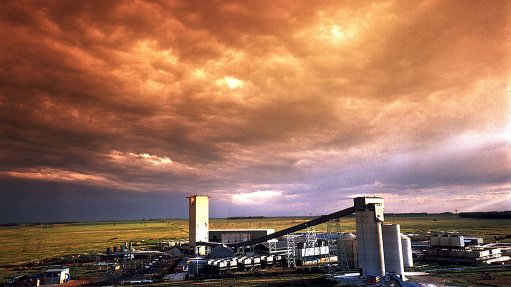
Name: Moab Khotsong mine.
Location: The mine is located in South Africa, near the towns of Orkney and Klerksdorp, about 180 km south-west of Johannesburg, Gauteng.
Controlling Company: AngloGold Ashanti.
Brief Description: Moab Khotsong is the newest of the South African deep-level mines. Three vertical shaft systems are maintained to service the mine. The orebody is divided through major faulting into three distinguishable blocks referred to as Top mine (Great Noligwa), Middle mine and Zaaiplaats.
Brief History: The Great Noligwa mine was merged with Moab Khotsong in 2014 and operations are now collectively referred to as Moab Khotsong. Great Noligwa started production in 1968 and Moab Khotsong started producing in 2003.
Products: Gold and by-products of uranium.
Geology/Mineralisation: The geology at Moab Khotsong is structurally complex, with large fault-loss areas between the three main mining sites. The geological setting is one of crustal extension, dominated by major south-dipping fault systems, with north-dipping Zuiping faults sandwiched between them. The De Hoek and Buffels East faults structurally bound the reef blocks of the Middle mine to the north-west and south-east respectively and the northern boundary is a north-dipping Zuiping fault. Extensive drilling is being undertaken on the extremities of the Middle mine, targeting potential preserved blocks. Close infill drill spacing is required to delineate the structural definition between the major structures to optimise the mine design and extraction of the orebody.
The Vaal reef (VR) consists of a thin basal conglomerate (the C-Facies) and a thicker sequence of upper conglomerates (the A-Facies). These two sedimentary facies are separated by the B-Facies, which is a layer of barren orthoquartzite. The A-Facies is the principal economic horizon at Moab Khotsong, but remnants of the C-Facies are sporadically preserved below the A-Facies. High gold values in the VR are often located at the base of this unit and are associated with high uranium values and the presence of carbon. Uranium is an important by-product.
The C reef is mined on a limited scale, in the central part of Top mine where a high-grade, north-south orientated sedimentary channel, containing two economic horizons, has been exposed. To the east and the west of this channel, the C reef is poorly developed, with relatively small areas of economic interest. As with the VR, high uranium values are also often associated with high gold values and the presence of a 5-mm- to 2-cm-thick carbon seam at the base of the conglomerate. To the north of the mine, the C reef subcrops against the Gold Estates Conglomerate Formation and, in the extreme south of the mine, the C reef has been eliminated by a deep Kimberley erosion channel and the Jersey fault. The C reef that is preserved in the eastern parts of the Middle mine has not been proven to be feasible for eventual economic extraction and has, therefore, not been included into the published mineral resource.
Reserves: Proven and probable reserves as at December 31, 2015, were estimated to be 16.88-million tonnes, grading 9.69 g/t of gold.
Resources: Exclusive resources as at December 31, 2015, were estimated at 24.26-million tonnes, grading 14.09 g/t of gold.
Mining Method: Mining at Moab Khotsong is based on a scattered mining method, together with an integrated backfill support system that incorporates bracket pillars. The economic horizons are exploited between 1 791 m and 3 052 m below surface.
Major Infrastructure and Equipment: Broken-rock handling is track-bound, transferring the rock to a number of inter level subvertical transfer systems that gravity feeds to the main silos on 77 level. Separate streams are used for waste rock and gold-bearing ore. The rock is hoisted to surface through the main shaft. From the shaft the ore is transported to the processing plant per rail and the waste rock is deposited on the low-grade stockpile using a conveyor belt system. The Moab Khotsong and Kopanang mines share the Great Noligwa gold plant, whose design capacity exceeds the maxi- mum planned production from the two mines. Gold and uranium are recovered through gold cyanide and acid uranium leaching.
Prospects: The initial development of Moab Khotsong was undertaken because the new mine would be well positioned to facilitate the exploitation of additional ore blocks adjacent and contiguous to current mining areas. The most important of these blocks are the Zaaiplaats blocks (Zaaiplaats, Area A, B and C), positioned to the south-west of the current Moab Khotsong infrastructure and extending below the existing mine.
Over the past few years, changes in key parameters and economic assumptions have reduced the economic viability of project Zaaiplaats. While the project remains part of the life-of-mine plan and ore reserve base, the project is currently subject to a prefeasibility study, which is scheduled to be completed in November.
Contact Person: Investor relations Stewart Bailey.
Contact Details:
AngloGold Ashanti,
tel + 27 11 637 6000,
email sbailey@anglogoldashanti.com, and
website http://www.anglogoldashanti.com.